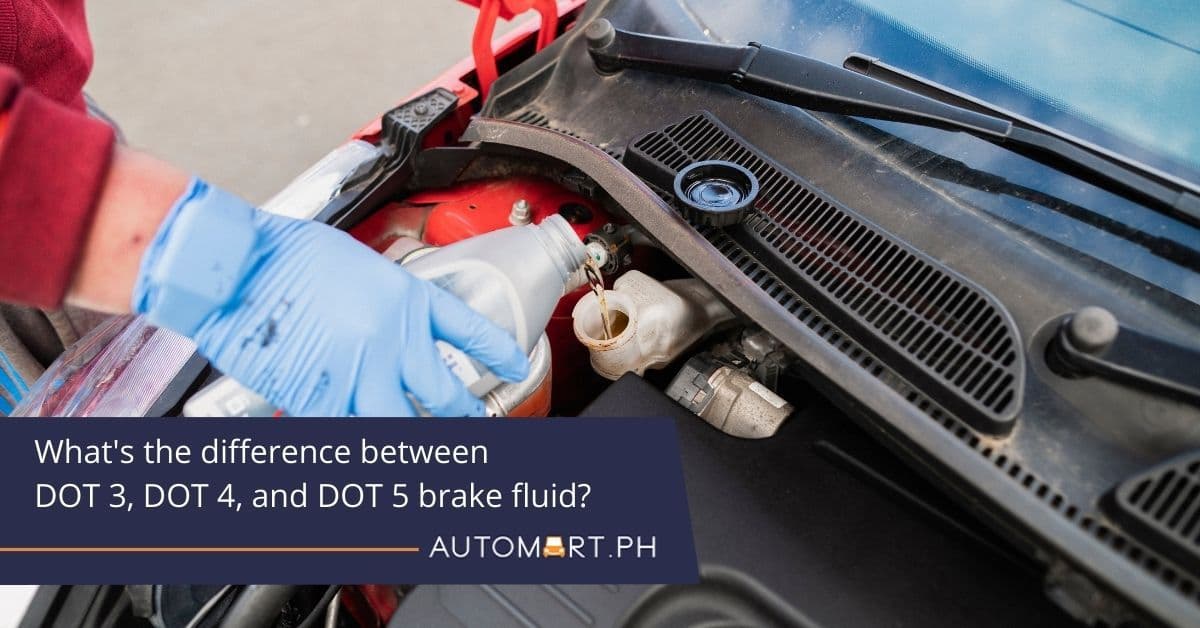
What’s the difference between brake fluids?
Updated on December 18 2025
The brake fluid is probably one of the most overlooked maintenance items in your ride. If you regularly change the engine oil to keep the engine humming, it’s also a good idea to change the brake fluid to keep those anchors in tip-top shape. However, buying a fresh bottle of brake fluid is not as simple as it sounds. Modern cars need either DOT 3, DOT 4, or DOT 5 brake fluid, but what’s the difference between each, and what is best for your vehicle?
What is brake fluid?
Brake fluid is a hydraulic fluid utilized by the braking system in your ride. Upon pressing the brake pedal, the brake fluid pushes the pistons in the caliper to grip the brake rotors, the reason why your car pulls to a stop or reduces speed when applying brake pedal pressure. In effect, the brake fluid transfers the force applied to the brake pedal to the brake calipers.

And since the brakes are operating in a high-friction and high-stress environment, the brake fluid needs to perform flawlessly at extreme temperatures and high-pressure scenarios. Furthermore, the brake fluid lubricates the rubber and metal components in the calipers and master cylinder to prevent rust and corrosion.
How does brake fluid affect braking performance?
Water vapor intrudes your car’s brakes via microscopic pores in the hydraulic brake lines and the build-up of air in the reservoir. Brake fluid is hygroscopic by design, meaning it absorbs moisture faster than any other fluid, and this can be a good and bad thing. For starters, absorbing water or moisture is good in preventing rust and deterioration of braking components.

But then again, too much water in the brake fluid significantly lowers the freezing or boiling point of the liquid. And when the brake fluid boils, moisture will turn to vapor inside the brake lines, giving your brake pedal a softer and spongier feel, effectively losing the ability to compress the calipers and stop your vehicle. It’s the reason why periodically flushing and changing the brake fluid is of utmost importance.
What’s the difference between DOT 3, DOT 4, and DOT 5 brake fluid?
Car owners need to choose between DOT 3, DOT 4, and DOT 5 when buying a fresh bottle of brake fluid. All brake fluids have a DOT (Department of Transport) rating, and the numbers relate to the fluid’s dry and wet boiling points. Generally, brake fluid with a higher boiling point will last longer than others with a lower number.

DOT 3 Brake Fluid
Most vehicles use DOT 3 brake fluid. It has a dry boiling point of 205 °C and a wet boiling point of 140°C. The dry boiling point refers to fresh brake fluid, while the wet boiling point is when the brake fluid has absorbed moisture after repeated use.
DOT 4 Brake Fluid
DOT 4 brake fluid has a dry boiling point of 230°C and a wet boiling point of 155°C. Since DOT 4 has a higher dry and wet boiling point than DOT 3, it offers better resistance to extreme heat and moisture to deliver reliable stopping power.
DOT 5 Brake Fluid
Unlike poly-glycol-based DOT 3 and DOT 4 brake fluid, DOT 5 is silicone-based, does not absorb moisture, and has a more watery consistency. DOT 5 brake fluid has a dry boiling point of 260°C and a wet boiling point of 180°C. With such impressive numbers, DOT 5 is better resistant to rust and corrosion and lasts longer than DOT 3 or DOT 4.
DOT 5.1 Brake Fluid
DOT 5.1 is a reformulated blend of DOT 5 brake fluid and is compatible with DOT 3 and DOT 4 braking systems despite being silicone-based. DOT 5.1 has the same dry and wet boiling point as DOT 5 and offers the same level of performance.
Can I mix DOT 3, DOT 4, and DOT 5 brake fluids?
You can mix DOT 3 with DOT 4 brake fluid, but the practice of mixing brake fluids is not advisable to prevent cross-contamination. When changing from DOT 3 to DOT 4, all the old fluid should be drained and flushed out of the system. It’s also a good idea to replace all the rubber components in the braking system when upgrading from DOT 3 to DOT 4.

It’s a different story with DOT 5 brake fluid. Since DOT 5 is silicone-based, it should never mix with glycol-based DOT 3 and DOT 4 brake fluid. And if you do, it could cause diminished braking performance and wheel lock-ups when stomping on the brake pedal.
On the other hand, DOT 5.1 brake fluid is compatible with DOT 3 and DOT 4 and mixes easily with non-silicone brake fluids with no detrimental effects on braking performance.
What brake fluid is best for my car?
Consult the owner’s manual. If your car needs DOT 4 brake fluid, use DOT 4. But if you want to upgrade, make sure to drain all the old brake fluid out of the brake lines. Make sure never to mix DOT 3 or DOT 4 with DOT 5 brake fluid, although it’s okay to mix glycol-based brake fluids with silicone-based DOT 5.1.